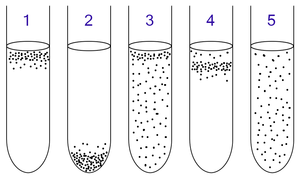Anaerobic organism

1: Obligate aerobic (oxygen-needing) bacteria gather at the top of the test tube in order to absorb maximal amount of oxygen.
2: Obligate anaerobic bacteria gather at the bottom to avoid oxygen.
3: Facultative bacteria gather mostly at the top, since aerobic respiration is the most beneficial one; but, as lack of oxygen does not hurt them, they can be found all along the test tube.
4: Microaerophiles gather at the upper part of the test tube but not at the top. They require oxygen but at a low concentration.
5: Aerotolerant bacteria are not affected at all by oxygen, and they are evenly spread along the test tube.
An anaerobic organism or anaerobe is any organism that does not require oxygen for growth. It could possibly react negatively and may even die if oxygen is present. There are three types:
- obligate anaerobes, which cannot use oxygen for growth and are even harmed by it
- aerotolerant organisms, which cannot use oxygen for growth, but tolerate the presence of it
- facultative anaerobes, which can grow without oxygen but can utilize oxygen if it is present
In humans beings these organisms are usually found in gastrointestinal tract.[1]
Metabolism
Obligate anaerobes may use fermentation or anaerobic respiration.
Aerotolerant organisms are strictly fermentative.
In the presence of oxygen, facultative anaerobes use aerobic respiration; without oxygen, some of them ferment; some use anaerobic respiration.
Fermentation
There are many anaerobic fermentative reactions.
Fermentative anaerobic organisms mostly use the lactic acid fermentation pathway:
- C6H12O6 + 2 ADP + 2 phosphate → 2 lactic acid + 2 ATP
The energy released in this equation is approximately 150 kJ per mol, which is conserved in regenerating two ATP from ADP per glucose. This is only 5% of the energy per sugar molecule that the typical aerobic reaction generates.
Plants and fungi (e.g., yeasts) in general use alcohol (ethanol) fermentation when oxygen becomes limiting:
- C6H12O6 + 2 ADP + 2 phosphate → 2 C2H5OH + 2 CO2↑ + 2 ATP
The energy released is about 180 kJ per mol, which is conserved in regenerating two ATP from ADP per glucose.
Anaerobic bacteria and archaea use these and many other fermentative pathways, e.g., propionic acid fermentation, butyric acid fermentation, solvent fermentation, mixed acid fermentation, butanediol fermentation, Stickland fermentation, acetogenesis, or methanogenesis.
Some anaerobic bacteria produce toxins (e.g., tetanus)
Culturing anaerobes
Since normal microbial culturing occurs in atmospheric air, which is an aerobic environment, the culturing of anaerobes poses a problem. Therefore, a number of techniques are employed by microbiologists when culturing anaerobic organisms, for example, handling the bacteria in a glovebox filled with nitrogen or the use of other specially sealed containers, or techniques such as injection of the bacteria into a dicot plant, which is an environment with limited oxygen. The GasPak System is an isolated container that achieves an anaerobic environment by the reaction of water with sodium borohydride and sodium bicarbonate tablets to produce hydrogen gas and carbon dioxide. Hydrogen then reacts with oxygen gas on a palladium catalyst to produce more water, thereby removing oxygen gas. The issue with the Gaspak method is that an adverse reaction can take place where the bacteria may die, which is why a thioglycollate medium should be used. The Thioglycollate supplies a medium mimicking that of a Dicot, thus providing not only an anaerobic environment but all the nutrients needed for the bacteria to thrive.[2]
References
- ^ "Anaerobic bacteria - Overview".
- ^ "GasPak System". Accessed May 3, 2008.
